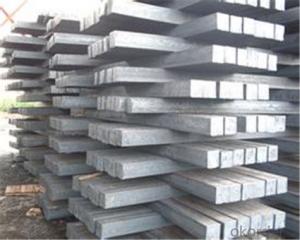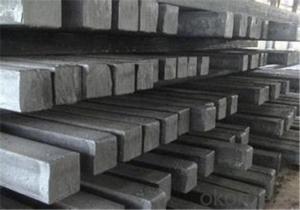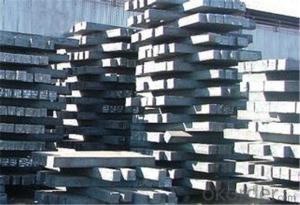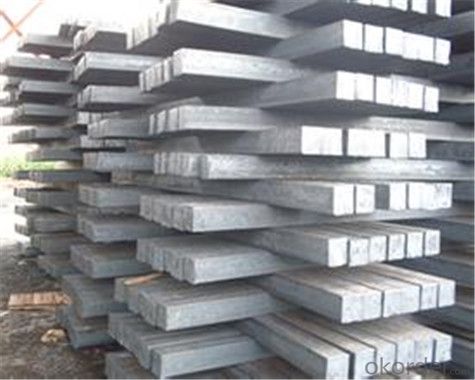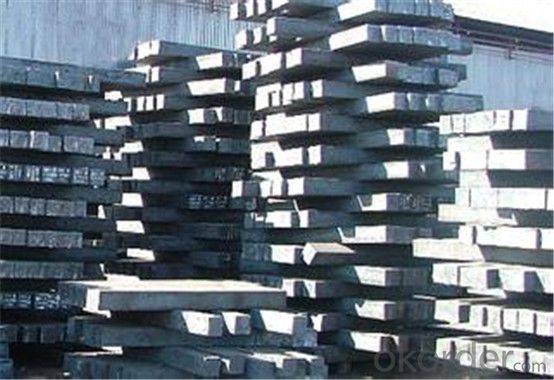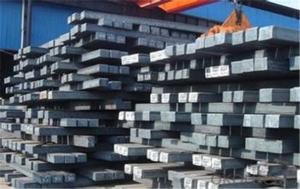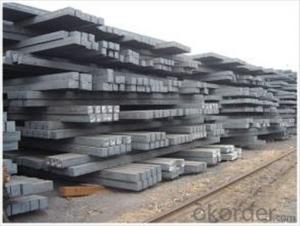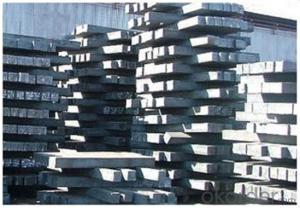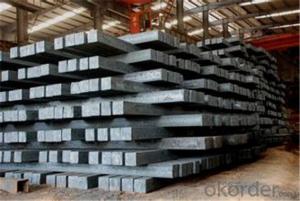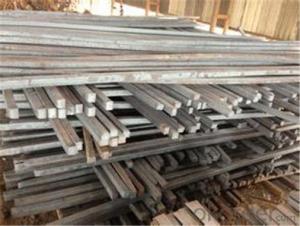Square Steel Billets Hot Sale Deformed Billet Q275/3SP in China
- Loading Port:
- Tianjin
- Payment Terms:
- TT OR LC
- Min Order Qty:
- 400 m.t.
- Supply Capability:
- 45555555 m.t./month
OKorder Service Pledge
OKorder Financial Service
You Might Also Like
Specification
Description of steel billet:
We procure world class quality steel billets which meets the specific requirements of the clients
The Billets produced by the company can be broadly divided into three main types i.e.
Festures of steel billet:
Billets are used for rolling of TMT Re-Bars of Fe415 and Fe500 Grade and various other structural steel products. Billets are used fro rolling of CRS TMT Re-Bars..
Specifications of steel billet:
Type | Steel billet / Square steel/ Steel square bar |
Standard grade | 3SP/PS, 5SP/PS, Q195, Q235, Q255, Q275, 20MnSi etc. |
MOQ | 1000 MT |
Technique | Hot rolled |
Size | 50*50mm ~ 160*160mm |
Length | 3~12m |
Packing | Loose packing, in bundle |
Payment terms | T/T, L/C at sight, Usance L/C |
Trade terms | EXW, FOB, CFR, CIF |
Trans terms | FIO, FILO, FLT |
Inspection | Third party inspection accepted |
Delivery time | 15-30 days, according to the quantity |
Applications | carbon structural steel, wire rod, rod, deformed bars, profile steel, machine parts, and steel moulds etc . |
Note | Customized service is available (for sizes,length and chemical components etc.). |
Images of steel billet:
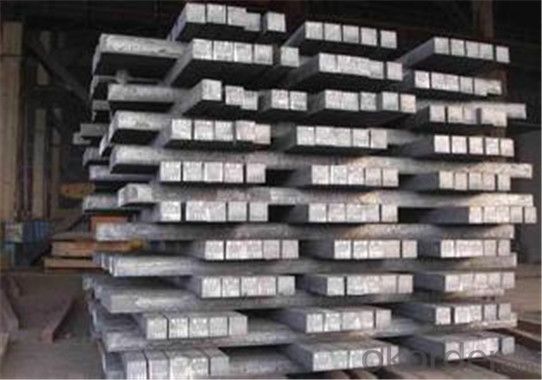
FAQ:
1. What is your package?
Packing situation: standard seaworthy packing or as customer required.
2. How long is the lead time?
Delivery time: 45 days after order confirmed.
3. What payment term do you accept?
Payment: T/T or L/C at sight.
- Q: How is steel wire rod used in the manufacturing of wire for solar panels?
- Steel wire rod is an essential component in the manufacturing process of wire for solar panels. The high-quality steel wire rods are first carefully selected for their strength, durability, and conductivity properties. These wire rods are then subjected to a series of manufacturing processes to transform them into the required wire for solar panels. The first step involves drawing the steel wire rod through a series of dies to reduce its diameter and increase its length. This process is known as wire drawing and is typically done using specialized machinery. By repeatedly passing the wire rod through smaller dies, the diameter of the wire is reduced while its length is increased. This results in a long, thin wire that is ideal for solar panel applications. Once the wire has been drawn to the desired diameter, it undergoes various treatments to enhance its performance and ensure its suitability for solar panel use. These treatments may include processes such as annealing, which involves heating the wire to high temperatures and then slowly cooling it down. Annealing helps to improve the wire's flexibility, strength, and electrical conductivity. After the wire has been treated, it is carefully inspected for any defects or imperfections. This quality control step is crucial to ensuring that the wire meets the stringent requirements of the solar panel industry. Any wires that do not meet the required standards are discarded, while those that pass the inspection are further processed. The final step involves coating the wire with a protective layer. This coating is usually made of materials like tin, silver, or copper, which provide corrosion resistance and enhance the wire's electrical conductivity. The coated wire is then wound onto spools or reels, ready to be used in the assembly of solar panels. In summary, steel wire rod is an integral part of the manufacturing process for wire used in solar panels. It undergoes various treatments, including wire drawing and annealing, to create a durable and highly conductive wire. By coating the wire with protective materials, its corrosion resistance and electrical properties are further enhanced. The resulting wire is then utilized in the construction of solar panels, helping to harness solar energy and contribute to a more sustainable future.
- Q: What is the standard length of steel wire rod?
- The specific industry and application play a role in determining the standard length of steel wire rod. Typically, lengths between 5.5 meters and 12 meters are produced. Nevertheless, it should be emphasized that customer-specific lengths can be manufactured upon request. Factors like intended use, manufacturing process, and transportation logistics contribute to determining the length of the steel wire rod.
- Q: What are the advantages of using steel wire rod compared to other materials?
- There are several advantages of using steel wire rod compared to other materials. Firstly, steel wire rod offers superior strength and durability. Steel is known for its high tensile strength, which means it can withstand heavy loads and resist deformation. This makes it an ideal material for various applications that require strong and reliable support, such as in construction, manufacturing, and transportation industries. Secondly, steel wire rod has excellent flexibility. Its elasticity allows it to bend and twist without breaking, making it suitable for applications that require dynamic movement or vibrations, such as in suspension systems, springs, and wire ropes. This flexibility also makes it easier to handle and install in various settings. Additionally, steel wire rod is highly resistant to corrosion. It can withstand exposure to moisture, chemicals, and extreme weather conditions without rusting or deteriorating. This resistance to corrosion makes steel wire rod a long-lasting and low-maintenance option, reducing the need for frequent replacements and repairs. Moreover, steel wire rod is readily available and cost-effective. Steel is one of the most commonly used materials worldwide, which means it is readily available in various shapes, sizes, and grades. This availability makes it easy to source and procure steel wire rod, reducing lead times and costs associated with production. Furthermore, steel's recyclability makes it a sustainable and environmentally-friendly choice. Lastly, steel wire rod offers versatility in terms of its applications. It can be used in a wide range of industries and settings, such as in construction, automotive, aerospace, agriculture, and telecommunications. Its adaptability and compatibility with various manufacturing processes make it a go-to material for many engineering and construction projects. In conclusion, the advantages of using steel wire rod compared to other materials include its superior strength, flexibility, corrosion resistance, availability, cost-effectiveness, and versatility. These qualities make steel wire rod a reliable and efficient choice for a wide range of applications.
- Q: What are the different surface inspection methods for steel wire rod?
- Steel wire rod can undergo a variety of surface inspection methods to ensure its quality and integrity. 1. The simplest and most basic method is visual inspection, where the surface is visually examined for visible defects like scratches, dents, or corrosion. 2. Another method is magnetic particle inspection, which involves applying a magnetic field and magnetic particles to the surface. Any defects or cracks cause the particles to cluster and become visible under UV light. 3. Eddy current testing is a non-destructive method that induces an electric current in the wire rod and measures the resulting electromagnetic field. Variations in the field can indicate surface defects. 4. Ultrasonic testing uses high-frequency sound waves to penetrate the surface. Defects or cracks reflect the sound waves, allowing for detection. 5. Dye penetrant inspection applies a liquid dye to the surface, which seeps into defects or cracks. After removing excess dye and applying a developer, the defects become visible. 6. Laser scanning is an advanced method that scans the surface using laser technology. It detects deviations from the normal surface profile and provides a detailed analysis. 7. X-ray inspection is used to inspect the internal and external surface of the wire rod. X-rays pass through the rod, and defects are detected by variations in the X-ray beam's intensity. Each method has its own advantages and limitations. The choice depends on specific requirements, the type of defects to be detected, and the desired level of accuracy.
- Q: What are the different types of steel wire rod coatings used for improved wear resistance?
- There are several types of steel wire rod coatings that are commonly used to improve wear resistance. These coatings are applied to the surface of the steel wire rod to provide a protective layer that enhances its durability and extends its lifespan. Some of the different types of coatings include: 1. Zinc Coating: Zinc coating, also known as galvanization, is one of the most widely used coatings for steel wire rods. It offers excellent corrosion resistance and protects the underlying steel from rust and other environmental factors. The zinc coating acts as a sacrificial layer, preventing the steel from coming into direct contact with the elements. 2. Polymer Coating: Polymer coatings are applied to steel wire rods to provide an additional layer of protection against wear and tear. These coatings are typically made from various types of polymer materials, such as polyethylene or polypropylene. Polymer coatings offer good abrasion resistance and can withstand harsh operating conditions. 3. Epoxy Coating: Epoxy coatings are popular for their exceptional adhesion and chemical resistance properties. These coatings form a strong bond with the steel wire rod surface, creating a protective barrier against wear, abrasion, and corrosion. Epoxy coatings are commonly used in applications where the wire rod is exposed to chemicals or harsh environments. 4. Ceramic Coating: Ceramic coatings are highly resistant to wear and can significantly enhance the lifespan of steel wire rods. These coatings are made from ceramic materials, such as aluminum oxide or zirconium oxide, which provide excellent hardness and heat resistance. Ceramic coatings are often used in high-stress applications where the wire rod is subjected to extreme temperatures and abrasive conditions. 5. Nickel Coating: Nickel coatings offer excellent corrosion resistance and are often used to protect steel wire rods from environmental degradation. These coatings provide a smooth and uniform layer that prevents oxidation and rust formation. Nickel coatings can also enhance the aesthetic appearance of the wire rod. Overall, the choice of steel wire rod coating depends on the specific application requirements, such as the operating conditions, expected wear and tear, and environmental factors. Each type of coating offers unique benefits in terms of wear resistance and protection, allowing manufacturers to select the most suitable coating for their specific needs.
- Q: How are steel wire rods used in the production of wire springs for various mechanical applications?
- The production of wire springs for mechanical applications requires the use of steel wire rods, which are indispensable components. These wire rods are made from top-quality steel and are designed to possess exceptional strength and durability. To ensure compliance with the necessary specifications, the steel wire rods are initially cleaned and inspected in the production process. Subsequently, they undergo a series of procedures involving heating and shaping the rods to achieve the desired wire diameter. This is typically accomplished through a technique known as hot rolling, which involves heating the steel rods to a malleable temperature and then passing them through a set of rollers to reduce their diameter. Once the wire rods have been reduced to the desired diameter, additional treatments are performed to enhance their mechanical properties. This can include heat treatment, which serves to improve the wire's strength and elasticity. This step is crucial in order to ensure that the wire springs can withstand the mechanical stresses they will encounter during use. Following this, the wire rods are coiled onto large spools, ready to be utilized in the manufacturing of wire springs. These spools are typically placed on specialized machinery that automatically feeds the wire into a coiling machine. The coiling machine shapes the wire into the desired spring form, whether it be a compression spring, tension spring, torsion spring, or others. Wire springs produced from steel wire rods offer numerous advantages in mechanical applications. They possess high tensile strength, enabling them to resist deformation and maintain their shape even under heavy loads. Additionally, they exhibit excellent elasticity, allowing them to stretch and return to their original shape without permanent deformation. Wire springs find widespread use in various mechanical applications, including automotive suspension systems, industrial machinery, furniture manufacturing, and numerous other industries. They play a vital role in providing support, absorbing shocks, and storing and releasing mechanical energy. By utilizing steel wire rods, these wire springs can endure the demanding conditions they encounter, ensuring the reliable and efficient operation of diverse mechanical systems.
- Q: What are the main factors affecting the fatigue resistance of steel wire rod?
- The main factors affecting the fatigue resistance of steel wire rod include the material composition and quality of the steel, the presence of any impurities or defects, the surface finish and treatment of the wire rod, the applied stress levels, the frequency and magnitude of cyclic loading, and the environmental conditions in which the wire rod is used. Additionally, the manufacturing process and heat treatment of the wire rod can also influence its fatigue resistance.
- Q: How is steel wire rod used in the production of wire mesh for agricultural applications?
- Steel wire rods are used in the production of wire mesh for agricultural applications by being drawn through a series of dies to reduce their diameter, resulting in wire of the desired thickness. This wire is then woven or welded together to form a mesh, which is used for various agricultural purposes such as securing fences, creating cages for livestock, and constructing trellises for plants. The strength and durability of steel wire rods make them ideal for withstanding the harsh conditions and heavy loads often encountered in agricultural settings.
- Q: What are the different types of steel wire rod coating processes?
- In the industry, there exist various types of steel wire rod coating processes. These processes aim to offer different levels of protection and enhance the wire rod's performance in diverse applications. Some commonly utilized coating processes comprise: 1. Galvanizing: A layer of zinc is applied to the steel wire rod in this process. Galvanizing delivers exceptional resistance to corrosion and finds extensive use in outdoor applications that expose the wire to severe weather conditions. 2. Phosphate coating: By treating the surface of the steel wire rod with phosphate compounds, a chemical process known as phosphate coating is employed. This coating improves the adhesion of subsequent coatings, such as paint or powder coating, and enhances corrosion resistance. 3. Electroplating: Using an electric current, a thin layer of metal like chromium or nickel is deposited onto the surface of the steel wire rod during electroplating. This process increases corrosion resistance and enhances the wire rod's appearance. 4. Polymer coating: The surface of the steel wire rod is covered with a layer of polymer material, such as PVC or polyethylene, in polymer coating. This coating safeguards against corrosion, abrasion, and chemical exposure, making it suitable for a wide range of applications. 5. Epoxy coating: Epoxy resin is utilized in epoxy coating to create a durable and corrosion-resistant layer on the steel wire rod. This type of polymer coating is commonly employed in applications that require high chemical resistance and mechanical strength. 6. Aqueous film forming foam (AFFF) coating: The AFFF coating is mainly used in fire-resistant applications of steel wire rods. It forms a thin foam layer on the surface, acting as a barrier against heat and fire to protect the wire rod. To ensure optimal performance and longevity of the steel wire rod, it is crucial to select the appropriate coating process based on the specific requirements of the application.
- Q: How can steel bars and bars be differentiated from each other in different uses?
- Round, also known as wire, is round steel with small diameter, the commodity form is rolled into plate supply, on the site in common with diameters of 6, 8, 10, 12 mm, with low carbon steel are generally not used for reinforcement of reinforced concrete structure, much used for steel sleeve, and small diameter for the brick reinforcement of brick concrete structure "".
Send your message to us
Square Steel Billets Hot Sale Deformed Billet Q275/3SP in China
- Loading Port:
- Tianjin
- Payment Terms:
- TT OR LC
- Min Order Qty:
- 400 m.t.
- Supply Capability:
- 45555555 m.t./month
OKorder Service Pledge
OKorder Financial Service
Similar products
Hot products
Hot Searches
Related keywords
